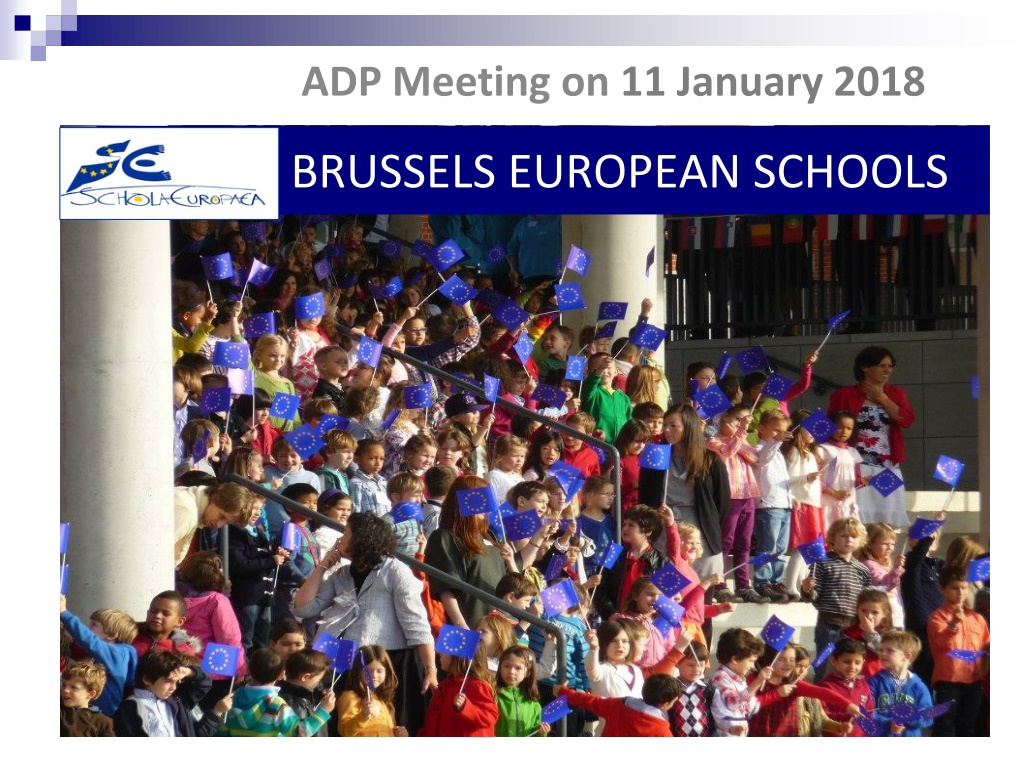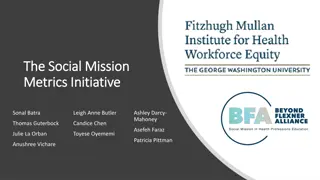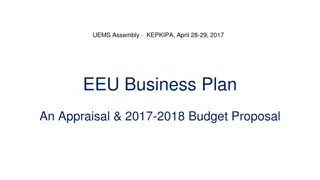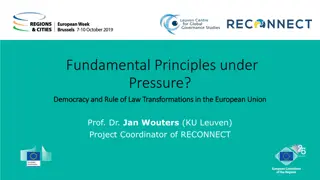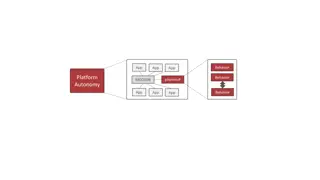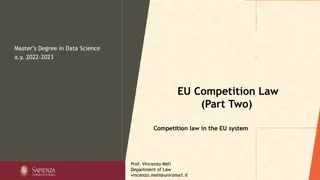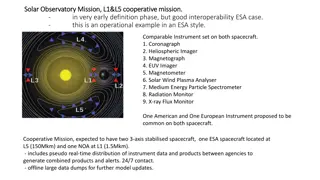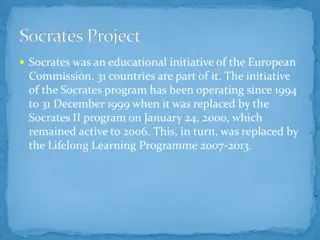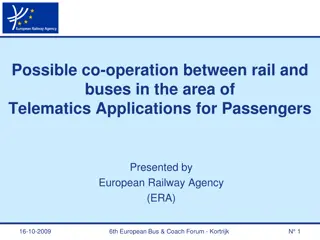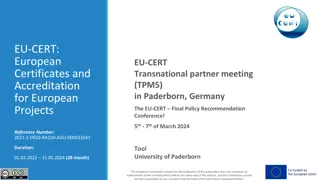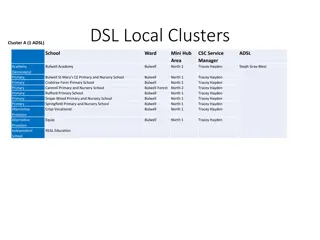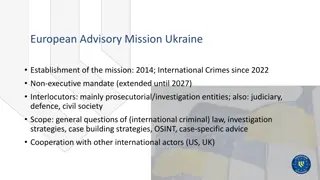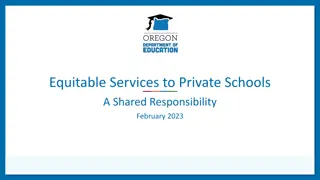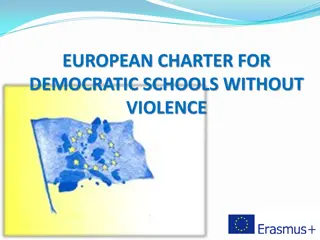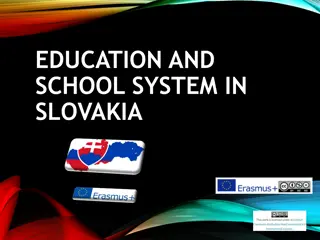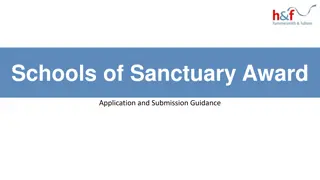Overview of European Schools: Structure, Educational Principles, and Mission
European Schools follow a unique structure with cycle classes and ages, offering multilingual and multicultural education. The educational principles emphasize language diversity and unity. The schools are jointly controlled by EU Member States, providing high-quality education across nursery, primary, and secondary levels. There are 13 schools in 6 countries, all sharing a mission to deliver excellence in education.
Download Presentation

Please find below an Image/Link to download the presentation.
The content on the website is provided AS IS for your information and personal use only. It may not be sold, licensed, or shared on other websites without obtaining consent from the author. Download presentation by click this link. If you encounter any issues during the download, it is possible that the publisher has removed the file from their server.
E N D
Presentation Transcript
ADP Meeting on 11 January 2018 BRUSSE BRUSSELS EUROPEAN SCHOOLS
What is the structure of the European Schools? Cycle Classes Age Early education (Nursery) 1 - 2 4 and 5 Primary 1 - 5 6 - 10 Secondary Observation cycle Pre-specialisation cycle Specialisation cycle 1 - 3 4 - 5 6 - 7 11 - 13 14 - 15 16 - 18 European Baccalaureate Educational Support Special Educational Needs (Educational Support) SWALS = Students Without A Language Section 3
Educational principles of European Schools Basic instruction is given in the official languages of the European Union. This principle allows the primacy of the pupil s mother tongue/dominant language (L1) to be safeguarded. Consequently, each school comprises several language sections. The curricula and syllabuses (except in the case of mother tongue) are the same in all sections. Also to foster the unity of the school and encourage genuine multi-cultural education, there is a strong emphasis on the learning, understanding and use of foreign languages. This is developed in a variety of ways 4
Who defines the pedagogical project? COMPLAINTS BOARD BOARD OF GOVERNORS TROIKA JOINT TEACHING COMMITTEE GENERAL SECRETARIAT BOARDS OF INSPECTORS Nursery-Primary Secondary Joint BUDGETARY COMMITTEE Secretary-General and DSG Baccalaureate Unit EUROPEAN SCHOOLING 13 European Schools 12 Accredited European Schools 5
Mission statement The establishments controlled jointly by the governments of the Member States of the European Union. In all these countries they are legally regarded as public institutions. European Schools are official educational The mission of the European Schools is to provide high quality multilingual and multicultural education for nursery, primary and secondary level pupils. 6
13 SCHOOLS IN 6 COUNTRIES School Country Year First BAC Luxembourg 1 Brussels 1 Mol Varese Karlsruhe Bergen Luxembourg Belgium Belgium Italy Germany The Netherlands 1953 1958 1960 1960 1962 1963 1959 1964 1966 1965 1968 1971 Brussels 2 Munich Brussels 3 Alicante Frankfurt Luxembourg 2 Brussels 4 Belgium Germany Belgium Spain Germany Luxembourg Belgium 1974 1977 1999 2002 2002 2004 2007 1982 1984 2001 2006 2006 2013 2017 7
What is the content of the curricula? Does it differ depending on the language section? Cycle Level AGE Language section Upper secondary s7 s6 s5 s4 18 17 15 14 L1 Choices L2 ECO L4? Lower Secondary L3 Hi, Geo, Rel s3 s2 s1 p5 p4 p3 p2 p1 13 12 11 10 9 8 7 6 L1, Math, Sci, Hum Sci Art & Mus L2 European Hours L1, Math, Disc Word, mus, art PE Primary Early education n2 n1 5 4 L1 8
Cycle Level AGE SWALS Upper secondary s7 s6 s5 s4 18 17 15 14 L2 Choices L1 ECO L4 Hi, Geo, Rel Lower Secondary L3 s3 s2 s1 p5 p4 p3 p2 p1 13 12 11 10 9 8 7 6 L2, Math, Sci, Hum Sci Art & Mus L1 European Hours L2, Math, Disc Word, mus, art, PE Primary Early education n2 5 L2 L1 n1 999 9
Teaching of Languages in the EE All the mother tongues of 28 countries + Maltese and Gaelic are taught (24 official; 23 as L1) Schools have 6-8 language sections Students without language sections= SWALS L2: English, French, German (European Hours in primary) History, Geography, Economy, Religion, Ethics in L2 in Secondary Art, Music, Sport etc. are taught in one of the L2 or HCL in Secondary L2 starts at 1st primary L3 starts at 1st secondary L4 can start at 4th secondary (optional) L5 = Complementary course secondary 6-7 + Latin (s2-) and ancient Greek (s4-) 10
LANGUAGE REFERENCE TABLE based on European Framework of Reference for Languages BASIC PROFIENCY LEVEL IN DIFFERENT CYCLES Early education 0 0 0 A 1.1 oral Primary A2 0 0 A 1.2 Secondary 3 Secondary 5 Secondary 7 B1 B2 A1+ A2+ 0 A1 A2 B1 L2 L3 L4 ONL C1 B1+ A2+ B2 11
European Baccalaureate The secondary school course is validated by the European Baccalaureate examinations at the end of the seventh class secondary. The awarded diploma is fully recognised in all the countries of the European Union, as well as in a number of others. Those awarded the diploma have the same rights and benefits, as other holders of equivalent qualifications in their countries, to seek admission to any university or institution of higher education in the European Union . 12
Table of equivalences of teaching levels/year groups Information available in the application form for the 2018-2019 school year (annex II of the General Rules of the European Schools). 13
ONL (Other National Language) Educational Support Special Educational Needs What about pupils who do not aim at European Baccalaureate? 14
The educational players of the European Schools The European Baccalaureate Seconded teachers Locally recruited teachers School management s role Inspectors role 15
What is the Central Enrolment Authority/CEA (Autorit Centrale des Inscriptions/ACI) and what are its tasks? Who and on what basis decides on the distribution of pupils/applications in the different schools/sites? The CEA is the administrative authority competent to take decisions on applications for enrolment at and transfers between the Brussels European Schools, in accordance with the provisions of the current Enrolment Policy. The details of its composition, the procedures governing its operation and its tasks are the subject of a set of Rules of Procedure (2016-11-D-25-en-3), which can be consulted on www.eursc.eu under Basic Texts For the 2018-2019 school year, the Policy on Enrolment in the Brussels European Schools (2017-12-D-5-en-3) can be consulted on www.eursc.eu under Enrolments 17
ENROLMENT THE DIFFERENT SCHOOL/SITES
European Schools/Sites in Brussels Brussels I Uccle Site (EEB1 - UCC Site) Brussels I Berkendael Site (EEB1 - BK Site) Brussels II (EEB2) Brussels III (EEB3) EEB4 Brussels IV (EEB4) EEB2 EEB3 EEB1 BK Site EEB1 UCC Site 19
Pupil population of the Brussels European Schools Pupil numbers 2012 3 040 - 3 144 2 892 1 530 10 606 10 977 Pupil numbers 2013 3 086 - 3 088 2 875 1 928 Pupil numbers 2014 3 277 - 2 961 2 908 2 260 11 406 Pupil numbers 2015 3 394 - 2 998 2 995 2 498 11 885 Pupil numbers 2016 3 344 165 3 056 3 041 2 703 12 309 Pupil numbers 2017 3 421 323 3 101 3 068 2 778 12 691 Theoretical capacity 3 100 1 000 2 850 2 650 2 800 EEB1-UCC EEB1-BK EEB2 EEB3 EEB4 Total 12 400 Pupil Population 12,691 13,000 12,309 12,500 11,885 12,000 11,406 11,500 10,977 11,000 10,606 10,500 10,000 2012-2013 2013-2014 2014-2015 2015-2016 2016-2017 2017-2018 20
What language sections exist in which school/site today? EEB1 - UCC Site Nursery DA DE EN ES FR HU IT PL Primary DA DE EN ES FR HU IT PL Secondary DA DE EN ES FR HU IT PL EEB1 - BK Site Classes Nursery FR LV SK DE DE Primary FR LV SK P1 P3 EEB2 Nursery DE EN FI FR IT LT NL PT SV Primary DE EN FI FR IT LT NL PT SV LT Secondary DE EN FI FR IT NL PT SV S1 S4 EEB3 Nursery CS DE EL EN ES FR NL Primary CS DE EL EN ES FR NL Secondary CS DE EL EN ES FR NL EEB4 Nursery BG DE EN ET FR IT NL RO ET Primary BG DE EN FR IT NL RO P1 P2 BG S1 S2 + at EEB1 BK Site : new satellite classes RO S1 Secondary DE EN - FR IT NL 21
Distribution of SWALS by school in Brussels EEB1 - UCC Site Nursery SL MT Primary SL MT Secondary SL MT EEB2 Nursery ET * - LV * Primary ET * - LV * LT Secondary ET * LV S5 S7 EEB3 Nursery SK * Primary SK * Secondary SK EEB4 Nursery - - HR - ET Primary - HR - P3 P5 BG RO Secondary ET HR S3 S7 S2 S7 * regrouping of siblings only 22
The European School, Brussels I Berkendael Site All schools/sites offer all-through schooling from the Nursery cycle to the European Baccalaureate. During its meeting of 1-3 December 2015, the Board of Governors approved temporary use of the Berkendael site as an extension to the European School, Brussels I pending opening of the European School, Brussels V. The Berkendael Site accommodates the nursery and primary cycles in their entirety. In September 2017: - nursery and primary cycles in the FR section, - nursery cycle in the SK and LV sections, - satellite German classes from nursery cycle to primary year 2. In September 2018: - nursery and primary cycles in the FR, SK and LV sections, - satellite German classes from nursery to primary year 3, - new satellite classes. 23
Open Days/Information Sessions The Brussels European Schools organise Open Days/Information Sessions for new parents. Nursery and Primary 24/01/18 from 1:00 pm to 2:30 pm 07/03/18 from 1:00 pm to 2:30 pm 16/05/18 from 1:00 pm to 2:30 pm EEB1 BK Site EEB1 UCC Site 24/01/18 pm (also for Secondary) 22/01/18 from 5:30 pm to 7:30 pm EEB2 14/05/18 from 11:00 am to 1:00 pm 21/02/18 from 9:00 am to 10:45 am (+ Secondary from 1:00 pm) EEB3 07/02/18 afternoon (also for Secondary) 25/04/18 afternoon (also for Secondary) EEB4 Full information is available on the Schools websites: www.eeb1.com www.eeb2.eu www.eeb3.eu www.eeb4.be 24
ENROLMENT APPLICATIONS
How, when and at what age should an application for enrolment be submitted? 2018-2019 Enrolment form - available: - from the intranet of each institution - on request, from the enrolment secretariat of each school. - to be handed in or sent to the school/site corresponding to the first preference expressed on the enrolment form. 2 enrolment phases 1st enrolment phase: from 11 to 30 January 2018 2nd enrolment phase: from 19 February to 15 June 2018 and from 2 July to 4 September 2018 For category I pupils whose parent is in post on 31 December 2017: submission of the application during the FIRST PHASE is mandatory. For category I pupils whose parent is taking up his/her post as from 1 January 2018: submission of the application during the FIRST or SECOND PHASE. 26
Age requirement - Nursery school: pupils will be admitted at the beginning of the school year in September of the calendar year in which the child reaches 4 years of age. (= children born in 2014) - Primary year 1: pupils will be admitted at the beginning of the school year in September of the calendar year in which the child reaches 6 years of age. (= children born in 2012) Pupils who are already attending one of the Brussels European Schools/sites during the 2017/2018 school year regardless of their cycle - will automatically be enrolled for the 2018/2019 school year. No NEW application for enrolment should be submitted. The school will automatically consult the parents regarding the optional subjects. The legal representative of pupils in P5 at the European School, Brussels I Berkendael Site during the 2017/2018 school year, will be required to submit, during the first phase, a transfer application to continue their schooling in the secondary cycle at the European Schools, Brussels I Uccle Site, Brussels II, Brussels III or Brussels IV. Les 27
- How should the language section be chosen? Who makes this choice in the event of doubts about the child's dominant language? - What can parents do if they contest this choice, lodge an appeal? Article 47(e) of the General Rules of the European Schools (2014-03-D-14-en-5), Articles 2.14. and 2.15. of the 2018-2019 Enrolment Policy A contentious appeal against the pedagogical decision taken by the school, together with the CEA s decision on award of a place in one or other of the schools, may be lodged with the Complaints Board of the European Schools. 28
Article 47 (e) of the General Rules of the European Schools A fundamental principle of the European Schools is the teaching of mother tongue /dominant language as first language (L1). This principle implies the pupil s enrolment in the section of his/her mother tongue/ dominant language where such a section exists. - This principle may be waived only where the child has been educated in a language other than his/her mother tongue/dominant language for a minimum of two years at primary or secondary level. The European Schools will presume in that case that the child will be capable of continuing his/her schooling in the language in question. - In schools where the section corresponding to a pupil s mother tongue/dominant language does not exist, he/she will generally be enrolled in one of the vehicular language sections. He/She will attend the classes in his/her mother tongue/ dominant language organised for so-called SWALS (Students Without A Language Section) as L1. - Parents will not be free to choose their child s first language (L1), its determination being the responsibility of the school s Director L1 must correspond to the child s mother tongue or dominant language, in the case of multilingual children, the dominant language being the one of which they have the best command. - Should there be any dispute about the pupil s L1, it will be the Director s responsibility to determine which language it is, on the basis of the information provided by the pupils legal representatives on the enrolment form and by requiring the pupil to take comparative language tests, organised and under the control of the school s teachers. The tests will be organised whatever the pupil s age and teaching level, i.e. including the nursery cycle. Determination of L1 at the time of the child s enrolment is definitive in principle ( ). 29
From the Institute of Education, London Report It is important to note that students are likely to transfer L1 skills to their L2 and L3. The greater a student s L1 proficiency, the greater his or her meta-linguistic awareness, and the better his or her L1 language learning habits and skills, the more likely it is that this proficiency, metalinguistic awareness and these language learning habits and skills will support learning of the L2 and the L3 and through the L2 and L3. 30
What is the content of the curricula? Cycle Does it differ depending on the language section? Level AGE Language section Upper secondary s7 s6 s5 s4 18 17 15 14 L1 Choices L2 ECO L4? Lower Secondary L3 Hi, Geo, Rel s3 s2 s1 p5 p4 p3 p2 p1 13 12 11 10 9 8 7 6 L1, Math, Sci, Hum Sci Art & Mus L2 European Hours L1, Math, Disc Word, mus, art PE Primary Early education n2 n1 5 4 L1 31
LANGUAGE REFERENCE TABLE based on European Framework of Reference for Languages BASIC PROFIENCY LEVEL IN DIFFERENT CYCLES Early education 0 0 0 A 1.1 oral Primary A2 0 0 A 1.2 Secondary 3 Secondary 5 Secondary 7 B1 B2 A1+ A2+ 0 A1 A2 B1 L2 L3 L4 ONL C1 B1+ A2+ B2 32
To which school/site should the application be submitted ? Order of preference The applicant will be invited to express an order of preference of the schools/sites, numbered from 1 to 5 (for the nursery/primary cycles) and 1 to 4 (for the secondary cycle), of which account will be taken as far as reasonably possible, without prejudice to application of the general enrolment rules. The applicant will hand in or send the enrolment application to the Brussels school/site corresponding to the first preference expressed on the enrolment form. The order of preference must be identical for joint applications. An application for the enrolment of each sibling must be submitted. 33
The European School, Brussels I Berkendael Site In view of the infrastructure currently made available and of the need to contain the overcrowding, filling the Berkendael site, which still has more than 650 unused places, is a priority for the 2018-2019 enrolment campaign: Enrolment application expressing a first preference for EEB1 BK Site will be dealt with first and foremost. Transfer to EEB1 BK Site will be allowed during the two enrolment phases and without any condition other than the submission of an application. If classes need to be created, the CEA will give priority consideration to locating them at EEB1 BK Site. Once there are a minimum of 7 pupils in the nursery cycle (N1+N2) and 7 pupils per year group in the primary cycle, the CEA can open a satellite class at EEB1 BK Site, except for pupils belonging to single language sections which are in the process of being set up (BG, ET and RO), Croatian and Slovenian SWALS and Maltese pupils. 34
ENROLMENT AWARD OF PLACES
Are all enrolment applications accepted? Category I pupils applications for enrolment in a multiple language section (present in several schools/sites)* : are entitled to attend one of the European Schools/sites in accordance with the general enrolment rules, i.e. not necessarily their first preference school/site, unless the existence of a special priority criterion, within the meaning of Article 8 of the Enrolment Policy, can be demonstrated. * Should the creation of satellite classes involve a Language 1 which had classes at only one of the other four schools/sites (single language section), the language section will then be treated as a multiple section. However, in view of the growth in the pupil population and of the infrastructure made available to the European Schools, the CEA is not in a position to be able to guarantee the award of a place to all category I pupils for whom an application for enrolment in one of the Brussels European Schools is made, even though everything possible is done to achieve that objective in the interests of the pupils already on roll and to be enrolled. 36
What are the priority criteria? Regrouping of siblings - admission to the same school of the siblings of category I pupils already on roll in a school during the 2017-2018 school year and continuing to attend it during the 2018-2019 school year. Return from assignment - return to the original school attended during at least one full school year immediately before the assignment on behalf of the European Commission or other EU institutions. These special priority criterion will be applicable only if the application is submitted during the first phase. 37
What are the priority criteria? Particular circumstances:Article 8.4. of the Enrolment Policy Where a pupil s interest so requires, duly established particular circumstances which are beyond the control of the applicants and/or the child may be taken into consideration to grant a priority criterion with a view to the pupil s enrolment at or transfer to one or more schools/sites of his/her choice. The priority criterion will be accepted only when it is invoked on submission of the application. The circumstances alleged by applicants must be set out in a clear statement of the facts, to which should be attached all the supporting documents appended to the enrolment application. Article 8.4.2. provides a list of the circumstances that are excluded from the circumstances that can be invoked as a special priority criterion to be deemed particular circumstances within the meaning of Article 8.4. of the Enrolment Policy. 38
What kind of guarantees are there of impartial and transparent distribution of places in the school(s) of parents' choice? For Phase I - A random ranking is organised under the supervision of Etude de l Huissier de Justice (Bailiff s Office) Jacques Lambert Article 6 of the Enrolment Policy: General rules for enrolment of category I pupils. Article 6.19. explains the order in which enrolment applications in a multiple language section are dealt with. Should the creation of satellite classes involve a Language 1 which had classes at only one of the other four schools/sites (single language section), the language section will then be treated as a multiple section. Article 10.6. of the Policy defines the order in which places are awarded. For Phase II applications will be dealt with in the order determined by the date and time of receipt of the application. General rules apply. Article 12.3. of the Policy defines the order in which places are awarded. 39
Order in which enrolment applications in a multiple language section (= classes in several schools/sites) are dealt with: The threshold for classes in all the language sections is set at: 20 pupils in the nursery cycle (N1+N2), 20 pupils per year group in the primary cycle, 26 pupils per year group in the secondary cycle. Article 6.19.a) of the Enrolment Policy: Places awarded in the 1st preference school/site, until the threshold has been reached. Article 6.19.b) of the Enrolment Policy: If there is no more place available in the first preference school/site: places awarded in the order of subsequent preferences expressed by applicants, to the classes of the schools/sites and the satellite classes which are already open or can be opened where places remain available until the threshold has been reached at all the schools/sites. 40
Order in which enrolment applications in a multiple language section are dealt with: Article 6.19.c) of the Enrolment Policy: Once the thresholds have been reached in all the classes at all the schools/sites and in the satellite classes, the CEA will award the reserve places in the least full class at the schools/sites concerned, in order to ensure balanced distribution of the pupil population across the schools and to avoid division of a class, until the maximum number of places to be filled has been reached. The maximum number of children is 30 pupils per class. See Document 2011-01-D-33-en, which can be consulted on www.eursc.eu: Revision of the Decisions of the Board of Governors concerning the organisation of studies and courses in the European Schools 41
ENROLMENT APPLICATIONS IN A MULTIPLE LANGUAGE SECTION To sum up THE CEA AWARDS PLACES AVAILABLE AT THE 1ST PREFERENCE SCHOOL/SITE until the threshold has been reached Article 6.19.a) of the Enrolment Policy 1. If no more places available in the 1st preference school/site, Article 6.19.b) of the Enrolment Policy 2. PLACES IN THE ORDER OF SUBSEQUENT PREFERENCES EXPRESSED BY APPLICANTS IN CLASSES AND SATELLITE CLASSES WHICH ARE ALREADY OPEN OR CAN BE OPENED If the thresholds have been reached at all the classes (including satellite classes) of all the schools/sites, Article 6.19.c) of the Enrolment Policy 3. THE RESERVE PLACES IN THE LEAST FULL CLASS AT THE SCHOOLS/SITES CONCERNED 42
When are answers regarding the allocation of places communicated to parents? From 11/01 to 30/01/2018 Handing in/Sending of enrolment and transfer applications to the Schools secretariats of the different sites From 15/02 to 21/02/2018 Communication of reference number by email and validation within a period of 7 calendar days 01/03/2018 27/04/2018 As from 27/04/2018 Publication of the random ranking on www.eursc.eu Publication of the places awarded on www.eursc.eu Notification of decisions of the CEA by email. Confirmation of acceptance or of refusal of the place offered within 8 calendar days. 15/05/2018 17/05/2018 Closing date of the first enrolment phase Publication of the places awarded and accepted on www.eursc.eu Information available in the application form for the 2018-2019 school year 43
How can parents appeal against the allocation decision if not happy? To whom? What is the procedure and who bears the costs? Parents are notified of the CEA s decisions individually by email. A direct contentious appeal against the CEA s decisions may be lodged with the Complaints Board of the European Schools. The detailed rules for the lodging of an appeal and the timescale (deadlines) are set out in Article 15 of the Policy and in the notification of the CEA s decisions. All information about the Complaints Board can be found at http://schola-europaea.eu/cree/ 44
Pilot project: cross-transfers scheme Articles 9.13. to 9.22. of the Enrolment Policy The legal representatives of children attending one of the Brussels schools/sites may submit a cross-transfer application, in order to offer to exchange the place held by their child for a place held by another child at a specific school/site, in anticipation of the beginning of the 2018-2019 school year in September 2018. Special online form. Applications submitted between 1 February 2018 and 14 February 2018. The application will be accepted if there is a corresponding cross-transfer application for a pupil in the same year group of the same language section for whom a transfer is sought to the school/site currently attended by the child of the transfer applicant whose application is being dealt with ( perfect transfer ). Allowed only if the optionscan be taught at the two schools/sites concerned. Solely for pupils who were on roll in the nursery classes and in classes up to and including S4 during the 2017-2018 school year. Cross-transfer applications will be irrevocable, the two pupils being automatically transferred by dint of the CEA s decision, without its being possible for the applicants to refuse the place offered. 45
